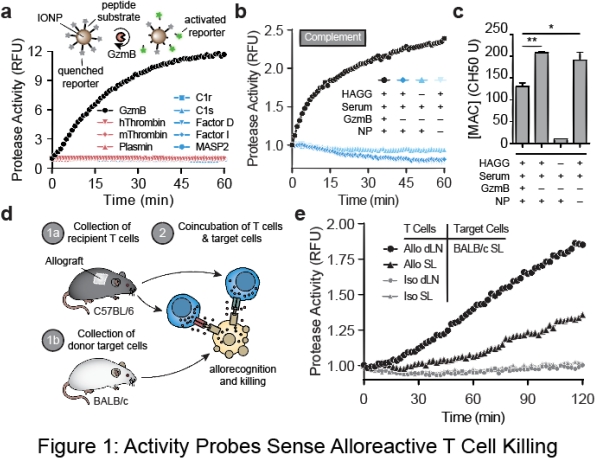Sensing T Cell Killing Activity with Granzyme B Activity Probes
1Department of Biomedical Engineering, Georgia Institute of Technology, Atlanta, GA
2Department of Surgery, Emory University School of Medicine, Atlanta, GA.
Meeting: 2018 American Transplant Congress
Abstract number: A44
Keywords: Bioengineering, Graft survival, T cell activation
Session Information
Session Name: Poster Session A: Biomarkers, Immune Monitoring and Outcomes
Session Type: Poster Session
Date: Saturday, June 2, 2018
Session Time: 5:30pm-7:30pm
 Presentation Time: 5:30pm-7:30pm
Presentation Time: 5:30pm-7:30pm
Location: Hall 4EF
Purpose: We developed activity-based probes that sense Granzyme B (GzmB) activity during alloreactive T cell killing of donor cells
Methods: FITC-labelled GzmB substrate (IEFDSG) was synthesized (TUCF) and conjugated to iron oxide nanoparticles (IONPs). In cleavage assays, activity probes are incubated with recombinant proteases and cleavage events are detected by fluorimetry. To activate complement, heat activated gamma globulin (HAGG) is added to control serum. Formation of membrance attack complex (MAC) are determined via ELISA (Quidel). Donor BALB/c skin was grafted onto recipient B6 mice. CD8+ T cells are enriched in B6 splenocytes and lymphocytes by MACS (Miltenyi). All animal experiments were approved by IACUC.
Results: We decorated IONPs with FITC-labelled substrates to develop GzmB activity probes. To test substrate specificity, we exposed our probes to recombinant proteases from coagulation and complement cascades (Fig 1a) as well as activated complement in serum (Fig 1b). In all cases, our probes were markedly activated only in presence of recombinant GzmB. Futhermore, we did not detect formation of MAC when our probes are incubated with serum, indicating that they do not activate complement via foreign surface (Fig 1c). To investigate the ability to sense alloreactive T cell killing, we added activity probes to cocultures of BALB/c splenocytes with CD8-enriched splenocytes or lymphocytes from recipient B6 mice bearing skin grafts. We detected increased activation kinetics of our probes in cocultures containing T cells from only allograft mice (Fig 1d,e). Overall, our activity probes are sensitive to GzmB, do not activate complement, and are able to monitor killing activity of recipient T cells against donor cells.
Conclusions: T cell-mediated graft injury is a major cause of acute transplant rejection. We developed GzmB activity probes that can sense alloreactive T cells killing of donor cells. This technology can be applied for in vivo imaging and monitoring of acute cellular rejection.
CITATION INFORMATION: Mac Q., Mathews D., Kahla J., Stoffers C., Delmas O., Holt B., Adams A., Kwong G. Sensing T Cell Killing Activity with Granzyme B Activity Probes Am J Transplant. 2017;17 (suppl 3).
To cite this abstract in AMA style:
Mac Q, Mathews D, Kahla J, Stoffers C, Delmas O, Holt B, Adams A, Kwong G. Sensing T Cell Killing Activity with Granzyme B Activity Probes [abstract]. https://atcmeetingabstracts.com/abstract/sensing-t-cell-killing-activity-with-granzyme-b-activity-probes/. Accessed December 10, 2025.« Back to 2018 American Transplant Congress

